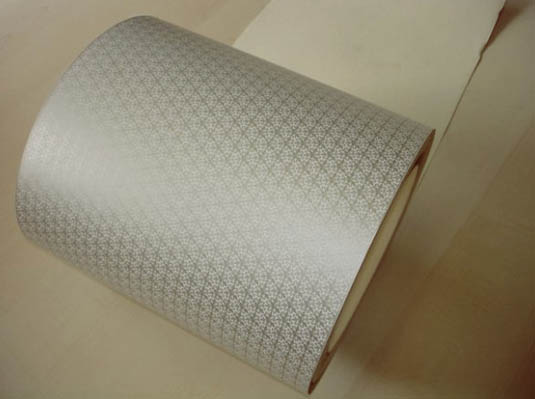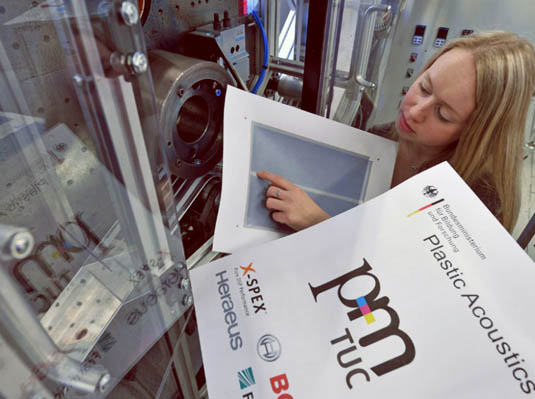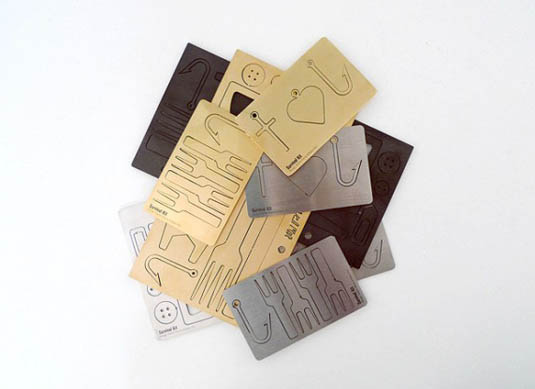 [Image: Wifi-blocking wallpaper from the Grenoble Institute of Technology].
[Image: Wifi-blocking wallpaper from the Grenoble Institute of Technology].
1) A collaboration between the Grenoble Institute of Technology and the Centre Technique du Papier has produced wifi-blocking wallpaper: a printable electromagnetic shield that “only blocks a select set of frequencies used by wireless LANs, and allows cellular phones and other radio waves through.”
As The Verge explains, the wallpaper uses “conductive ink containing silver crystals” printed in an otherwise innocuous abstract snowflake pattern. In other words, only if you know exactly what to look for—or in a strange moment of speculative paranoia—would you realize that the paper on the walls around you is actually an electronic device.
Competitively priced with standard wallpapers, it might soon be decking and protecting the walls in a house or office near you.
 [Image: Printed electronics produce 2D loudspeakers; photo by Hendrik Schmidt, via Printed Electronics World].
[Image: Printed electronics produce 2D loudspeakers; photo by Hendrik Schmidt, via Printed Electronics World].
2) 2D printable loudspeakers have become a reality. Fully functioning speakers can now be “printed with flexography on standard paper” using “several layers of a conductive organic polymer and a piezoactive layer.”
Like something out of The Ticket That Exploded, we read that “paper loudspeakers could, for instance, be integrated into common print products. As such, they offer an enormous potential for the advertising segment.” In other words, books, newspapers, and magazines could soon literally be yelling at you to buy more products. Less cynically, though, this also raises the fairly fascinating possibility that we could someday release songs inside pamphlets, audiobooks inside the very hardcovers they narrate, field recordings inside road maps, or even add strips of ambient acoustics to rooms through loudspeaker wallpaper.
After all, sound wallpapers are, incredibly, also possible, resulting in large-scale, acoustically active surfaces, from objects to interior walls. The rave of the future will be one person with a roll of paper, pasting up sounds till sunrise.



 [Images: Lasercut survival kits by Steffen Kehrle].
[Images: Lasercut survival kits by Steffen Kehrle].
3) However, if wifi-blocking wallpaper and printable 2D loudspeakers aren’t your cup of tea, then you can also laser-cut any reasonably stiff 2D surface into an urban survival kit.
Designer Steffen Kehrle‘s work implies that, with the right laser patterns and a thin sheet of cardstock—even wood veneer—the keys to the city could be yours. Done right, this same approach could offer more than just tactical culinary devices, as seen above, but small-scale urban equipment: pop-out objects for navigating the built environment around you.

How about pop-out objects for entering the locked environment around you?
Toool Emergency Lock-Pick Card
Seeing as a dynamic microphone is just a speaker run in reverse, the potential for my newspaper to be listening to me is more disconcerting than having it yell at me.
But on the other hand – in a voice-activated home, walls with ears could come in handy.
'cause you're gonna need four forks to eat all the fish you catch with that one hook
Fascinating on one hand, yet potentially creepy, as dhemran points out…
That wi-fi wallpaper seems really interesting – potentially a must have product in the near future. I was researching into materials which could block mobile phone signals for a project a long while ago and came up with a guy in Japan who had invented magnetic wood for that very purpose.
http://www.newscientist.com/article/dn2461-magnetic-wood-blocks-mobile-phone-signals.html
The wallpaper is just so much easier though. Funny, but i think the role of architecture as shelter is going to come right back into focus again, only this time it wont be from the weather, it'll be our primary self-defense against invasive signals, roaming monitoring devices and electronic zombies.
It's a brave new world remember.